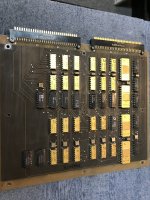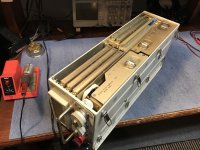Qbus
Veteran Member
Picked up a couple Westinghouse prototype computers that were part of the first-generation systems used on the F-16, No microprocessor chip, all discreet components. They have around eight cards in them. Two memory cards that are 4K by 8, a termination card, what appears to be a serial card, a dual A to D card and what I think are five cards that make up the processor. Two identical cards labeled CU that have several old Harris 0512-5B 64 X 8 PROMS and a lot of 9300 series 4 bit shift registers and two more identical cards labeled AU that have four AM934151 chips along with a bunch of additional 9300 4 bit shift registers and 9338 8 bit “deluxe” registers. Don’t know for certain yet but thing eight of them may make up the main registers for the processor. There is also a fifth card labeled “priority” but not looked too much at that yet. Interestingly I have not found any evidence of a clock yet? There is a crystal on the I/O card but think that’s just for serial port.
Have done a little with primitive systems before, but this may be the oldest system so far. Somewhat surprised by the use of static RAM and not core to retain the program, program code must have been stored somewhere external and loaded somehow or just hard coded into the structure of the processor.
Did quick inventory of all the devices on the AU and CU cards and there is nothing like a 1802 or CD4004 to be found unless its lurking on the priority card so for now I am sticking with the idea of discrete components.
What I need now is some information of how discreet processors were built back in the days before the microprocessor. Any help in finding sites with that sort of information would be really helpful.
Have done a little with primitive systems before, but this may be the oldest system so far. Somewhat surprised by the use of static RAM and not core to retain the program, program code must have been stored somewhere external and loaded somehow or just hard coded into the structure of the processor.
Did quick inventory of all the devices on the AU and CU cards and there is nothing like a 1802 or CD4004 to be found unless its lurking on the priority card so for now I am sticking with the idea of discrete components.
What I need now is some information of how discreet processors were built back in the days before the microprocessor. Any help in finding sites with that sort of information would be really helpful.


